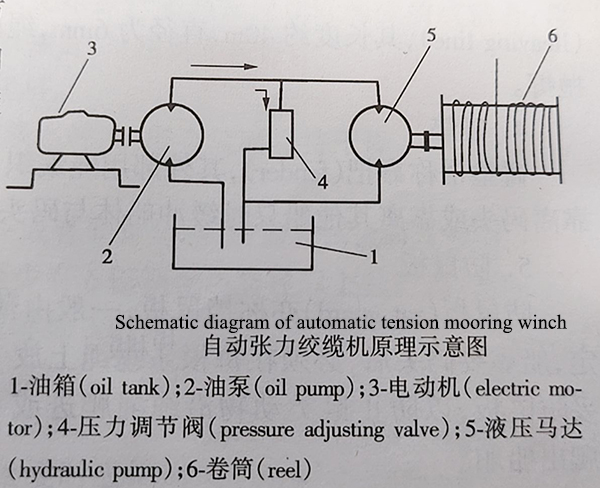
What is the automatic tension mooring winch?
The ship has been equipped with an automatic mooring system. The power sources of automatic cable-tying machines are both electric and hydraulic. The basic principle is to apply an adjustable dynamic moment to the winch drum to maintain balance with the tension moment caused by the tension on the mooring cable. When the ship's draft changes or is affected by tides or wind, resulting in an increase or decrease in the tension of the mooring line and deviating from the specified value, the automatic mooring machine can automatically retract and release the mooring line, stabilizing its tension to the specified value. In this way, it can prevent the cable from breaking, ensure mooring safety, and reduce the operation and labour intensity of the on-duty personnel.
Overview
The ship has been equipped with an automatic mooring system. The power sources of automatic cable-tying machines are both electric and hydraulic. The basic principle is to apply an adjustable dynamic moment to the winch drum to maintain balance with the tension moment caused by the tension on the mooring cable. When the ship's draft changes or is affected by tides or wind, resulting in an increase or decrease in the tension of the mooring line and deviating from the specified value, the automatic mooring machine can automatically retract and release the mooring line, stabilizing its tension to the specified value. In this way, it can prevent the cable from breaking, ensure mooring safety, and reduce the operation and labour intensity of the on-duty personnel. The following diagram is the working principle of the electric hydraulic automatic cable winch.

When the cable relaxes and the tension decreases, the automatic control pressure regulating valve 4 acts to close the pressure valve. The high-pressure oil pump 2 discharges the high-pressure oil and enters the hydraulic motor 5, driving the shaft and reel to rotate clockwise to tighten the loose cable.
When the tension reaches the original specified value, the pressure valve automatically opens again, and most of the pressure oil flows through the pressure regulating valve to the storage tank 1. A small amount of oil enters the hydraulic motor to replenish the leaked oil, causing the drum to stop rotating. When the tension of the mooring cable is greater than the hydraulic compression force inside the hydraulic motor, the mooring cable will pull the motor to reverse and release the cable. For example, if the force of the mooring cable is 9.8kN, it can be adjusted to 9 First gear of 8kN. When the wind blows the ship away and the force on the mooring cable is 9.8kN or more, it will automatically release without breaking the cable; When the gust of wind passes and the force on the mooring line is less than 9.8kN, the loose part of the cable is immediately automatically retracted to maintain force balance in the system. If the tide rises and the ship is high, the mooring line will automatically loosen when the force exceeds 9.8kN. When the force is less than 9.8kN, it will be tightened to keep the ship close to the dock.
The hydraulic motor discharges oil in reverse and mixes it with the oil discharged by the high-pressure liquid pump, then circulates through the pressure regulating valve towards the low-pressure liquid circuit. When using an automatic cable-tying machine, there must be a corresponding rotating cable guide device (universal cable guide).
Since the cables of the automatic cable-tying machine must be wound on the cable reel, the quantity is limited. Generally, a 10n00-ton cargo ship only has two head cables and two tail cables that can automatically retract and release, which can only meet the general situation. When the ship's draft changes significantly or the tension of the cables changes greatly due to tides and wind, it is still necessary to manually adjust all cables on time. According to IMO's requirements, the automatic tension winch of a moored oil tanker should be placed in a "non-automatic" working state.
For more marine winch information, kindly please click here.





